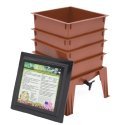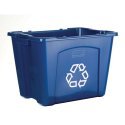What is a Compost Pile?
Normally a compost pile aka compost heap is just a place out in the backyard where people throw there organic wastes. But when studied, the compost pile becomes a living and thriving focus of knowledge about the world in which we live. A metropolis, of thermophylic microorganisms, that purify all of humankind’s organic wastes, in a natural and energy efficient manner. The compost pile becomes an intense learning environment for people interested in planning and meditating around an alternative future, filled with hope.
Many years ago in the ancient underground Greek cities of Kappadokya, in what is now central Turkey, organic wastes were dealt with by creating humus, and planting it in the garden. They did this by building compost piles and maintaining them. An art as simple as composting, brought prosperity to grape fields, and enriched an already fertile soil… When the Romans introduced sewer systems into western culture, they knew not the grave dangers that they would be creating through river sacrificing.
But compost piles survived the invasion of the Roman Empire, and can still be found today. Thriving metropolises of microorganisms and thermophylic decomposers, compost piles love to eat organic waste and turn it into the rich earthy substance we call humus. Dividing compost into “hot” piles and “cold” piles is most common. Hot piles usually are faster at producing humus, and cold piles take a little longer. Depending on what kind of pile used it could take 1 - 2 years to produce humus or as little as 6 weeks. It really just depends on how much care a person puts in to their compost pile.
A compost pile involves some basic equipment if it is to be done properly and safely. On the other hand, if humus is the only goal, then just dig a hole and throw the compost in it, cover it up with about eight inches of soil and that’s it (a real Kappadokian style “cold” compost pile). Later on however, humankind learned that by layering the ground with some highly carbon decomposers, like sawdust, peat-moss, wood chips, or old hay, by building walls and a roof, and keeping it far enough away from the house (at least 2 feet) to keep critters that might want to get into it outside, we could control the conditions of the compost. By keeping the compost “out” of the natural elements like rain, wind and snow, it can become a better place for thermophylic microorganisms.
Thermophylic microorganisms are important in a compost pile, since they are responsible for sanitation. They can get the interns of a compost pile up to a 140 degrees F, far above the necessary temperatures for killing any bad news pathogens. Microoganisms that do the job of composting need four basic elements for survival: oxygen, carbon, nitrogen and temperature. The different temperatures will define the kind of microorganisms that can exist at any given time, but oxygen, carbon and nitrogen are needed by all. Oxygen they breath, carbon gives them the energy they need to keep on going, and nitrogen offers stuff like proteins, cell structure, and genetic material.
By keeping the compost pile properly turned (could be once a week or month), the amount of oxygen can be evenly distributed throughout the whole pile. There are other ways, of course, like ventilating the compost pile, installing shafts in it from the very start or just basically shoving holes in it from the top. But turning, helps equally distribute the thermophyles, as well as mulching the compost better to give it a better look. In the end, an earthy smell should be obtained, and when you pick any given part of the compost pile up in your hands, that Grizzly Adams log house living off the land and in perfect harmony with nature kind of feeling should fill the human soul. If that happens, or something similar to that, then humus has been achieved, the compost pile is a success, and so is the person who composted it.





